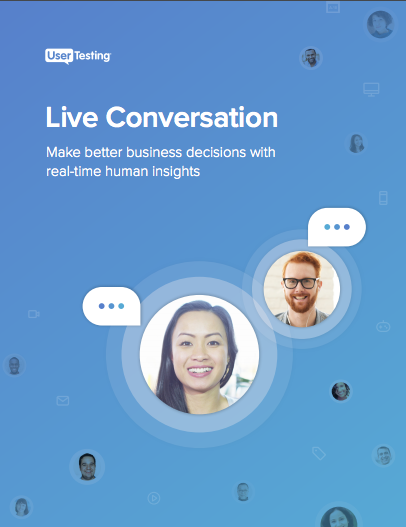
How to get honest feedback from your customers

People love to make other people happy. They want the people around them to feel good. They avoid hurting one another’s feelings. They know what it’s like to hear things they don’t want to hear—and want to avoid making others feel that way. Sometimes, to achieve this, they might even lie. The lies aren’t malicious—they’re about making other people happy and not hurting them. However, when it comes to customer research, you want people to be honest—even brutally honest—when you are trying to figure out what to build. So how do you ask questions that promote that level of honesty? When putting together a moderated discovery interview guide, it’s critical to ask the right questions in the right order about the concepts that matter most to you. In essence, you’re asking people to help you to construct a story about how they live, what they need, and what they expect. You can then leverage that story to keep your team honest as they’re making decisions about what to build and how to build it.
A few basic rules of thumb for customer interviews:
- Ask indirect questions that help to shed light on the how and the why.
- Prompt participants to tell narrative stories by asking series of questions that start with the big picture and then probe for detail.
- Let participants speak with minimal interruption.
Think in terms of a guide, not a script
You’ll notice that I framed the set of questions that you’re writing as a guide and not a script. One of the benefits of having a real-time conversation with someone is that you can probe further and adjust the conversation to fit your needs. Think about what probes you might want to use as follow-ups. For example: Scenario: You’re considering creating an app that helps people plan and manage household chores in a setting where there are multiple people who are responsible for maintaining the house. The team wants to ask potential users about how they negotiate who does what. They’re considering integrating a questionnaire that drives the best approach to scheduling chores based on household members’ preferences into the app sign-up process. Objective: Learn about how dishwashing fits into household management
- Tell me about your daily chores at home. What do you do? (Here, you want to learn what they really do - without leading them. If they do not report washing dishes, you may opt to skip the rest of the line of questions)
- (probe about eating habits at home) How often do you eat at home? (Not everyone eats at home every night. You want to know whether they are cooking at home or ordering in—that can make a significant difference in the number of dishes dirtied.)
- (probe about dishwashing) How do you clean dishes (assuming they use dishware vs. disposable)? (People have different preferences and desires around how they clean dishes. Here, you want to learn what tools they use and their typical practices.)
- (probe about preferences) What do you like about the process? (Some people love leaving the kitchen looking spotless at night. Some people love the meditative nature of dishwashing. Some people wash dishes because they don’t want ants. Find out what motivates people to wash dishes—or to avoid it.)
- What do you dislike about the process? (Learn about opportunities to make the process of washing dishes better.)
- About how much time did you take you to clean dishes last night? Was it a normal night for you? (Zoom in on a definition of success, i.e., minimal time spent washing dishes, an area of opportunity, or learn about whether this was an outlier or normal night to determine how much time it typically takes.)
Focus on the past—the future is uncertain
Asking people to report if they would behave a certain way in the future is almost certainly guaranteed to get you a poor answer. People can’t predict the future or what they’ll think with accuracy. However, they do a great job describing what they’ve done in the recent past. Takeaway: Screen participants to be sure that you’ll interview people who’ve recently completed or who are in the process of doing an activity about which you want to learn. Ask them to describe what they actually did.
Getting to how and why
To get people to tell you a story, you need to ask them questions in a way that gets them to be descriptive about their reality. While this often means asking questions that start with “how” and “why,” this doesn’t always have to be the case. Here are a few examples of how to improve your questions:
Bad | Good | |
What’s the best way to wash dishes? Why: Given the perfect world scenario, people will talk about what could be. You want reality. | How did you wash dishes last night? Why: Give people an opportunity to tell their story in a judgment-free way. | |
Do you think that you’d use an app that enables you to assign chores based on what people in your household enjoy doing? Why: This is a hypothetical. People have a difficult time answering hypothetical questions. Also, it’s leading; they don’t want to disappoint you so they may say yes (i.e., lie) to avoid hurting your feelings. | How do you assign chores? Would you like to change how you do it? Why or why not? Why: This indirect way of figuring out based on their story what areas of opportunity exist is better.When you ask a number of people about how they engage in an activity and learn about whether there are opportunities based on what they actually do, you are better positioned to make the right strategic or design choices. | |
Rate on a scale of 1-5 how often you’d use an app that would send reminders about when you need to do chores. Why: Again, this is a hypothetical. Also, everyone aspires to be better organized. It is possible that people would rate this highly but might not actually like reminders. | How do you manage reminders about chores? About how much do you spend to do it? Are you looking for a way to change how you manage those reminders? Why or why not? Why: Stories help you find the gaps better than ratings and hypotheticals. You’ll also learn about much money people are currently spending and what sort of systems people have in place for managing this information. |
Other great ways to frame questions that prompt description and story-telling:
- Tell me about a time when you….
- Describe how you last….
- Show me how….
- What are all the tools that you use to….
Use body language and silence
When using Live Conversation, you have the ability to turn on both your camera and the participant’s. Watch what they are doing and react to them appropriately. If they look like they’re about to talk or to continue, wait for a beat before you start talking. This gives them space to finish their thought without interruption. Silence also has the benefit of prompting people to talk; they like to fill it. Use quiet as a prompt.
Final thoughts
It's likely that you will want to do multiple rounds of interviews with people to start with the broader objective first and then narrow down to hone in on clarifying questions later. In your first round of interviews, you may choose to focus on discovering the laundry list of pain points, for example, and in later rounds, focus on an individual pain point. Discovery interviews aren’t always about validating an existing idea; sometimes, you need direction on what problems to solve. By posing open questions without a specific goal in mind, you open yourself up to learning more about your customers. Also, it helps to be open to “bad” surprises that let you know that you might be heading down the wrong path. The greatest power in discovery is in building empathy with your customers. Understanding what they need, how they live, what they prefer, and who they are helps your team to put themselves in customers’ shoes in all of the work you do.
Want to learn more?
If you’d like to learn more about how UserTesting can help you understand your customers through on-demand human insights, contact us here.
In this Article

Get real-time human insights with Live Conversation
Get real-time human insights with Live Conversation